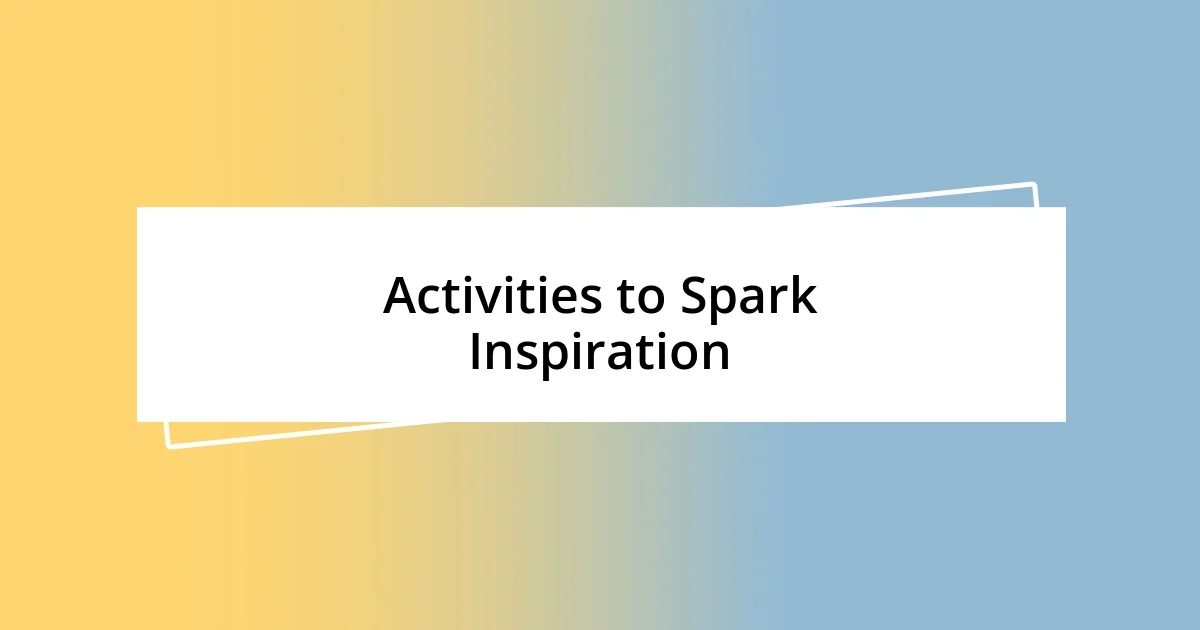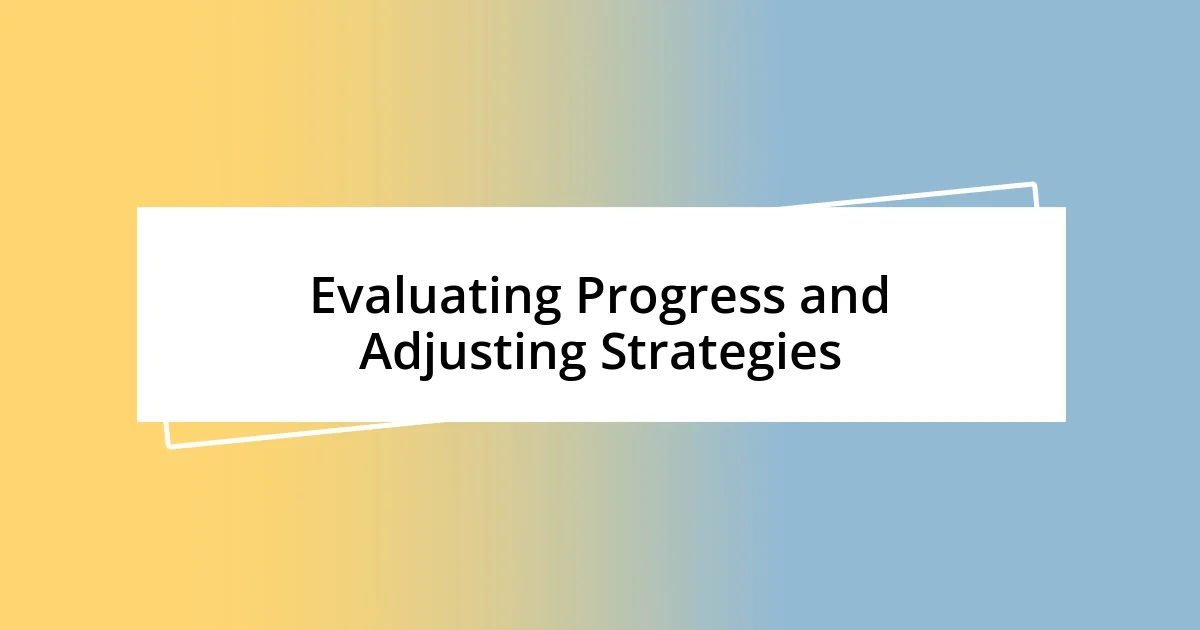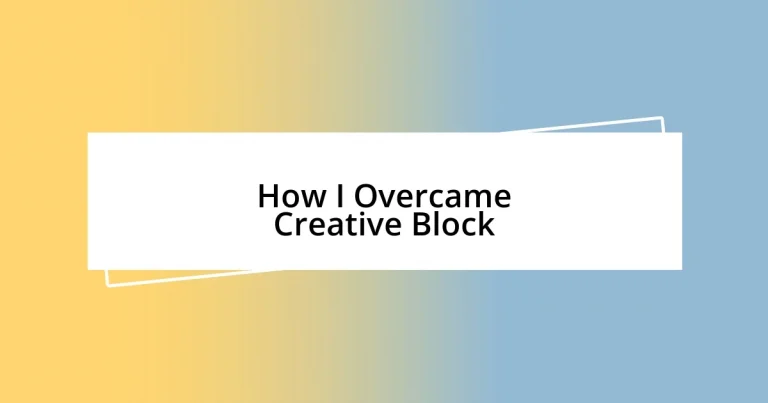Key takeaways:
- Creative block often stems from self-doubt and external pressures, and recognizing personal triggers is essential for overcoming it.
- Implementing routine changes and engaging in different creative activities can spark inspiration and rejuvenate creativity.
- Regular evaluation of progress and seeking feedback from others are crucial for adjusting strategies and maintaining long-term creative flow.

Understanding Creative Block
Creative block is more than just a simple pause in productivity; it’s often a wave of self-doubt crashing over our minds. Have you ever stared at a blank page, feeling like the words just refuse to flow? I remember a time when I sat in front of my canvas, completely frozen, questioning my abilities rather than trusting my instinct.
Sometimes, I find that underlying stress or external pressures can amplify creative block. For instance, there was a period when work demands overshadowed my passion for painting, leaving me drained and uninspired. It made me wonder: how can I reclaim that spark when life feels so demanding?
Understanding creative block requires recognizing its triggers—be it anxiety, fear of judgment, or simply feeling overwhelmed. I’ve experienced those moments of frustration firsthand, where every idea I had felt lackluster or derivative. It’s in those tough spots I’ve learned that acknowledging the block is the first step toward overcoming it.

Recognizing Personal Triggers
Recognizing personal triggers is crucial in navigating creative block. I’ve noticed that certain situations, like tight deadlines or negative feedback, can quickly sap my creative energy. Once, after receiving critical comments on a project I was passionate about, I found myself doubting every idea that popped into my head, feeling as though my creativity had vanished overnight.
In my journey, I’ve also discovered that self-imposed pressure can be a significant trigger. For example, when I set unrealistic expectations for my artwork, I often freeze up, allowing self-doubt to creep in. It’s fascinating how a little pressure can transform into a debilitating force instead of a motivator; recognizing this cycle has allowed me to reframe my approach, making the creative process more enjoyable and less stressful.
Interestingly, I’ve learned to identify environmental triggers as well. Some days, working in a cluttered space makes me feel overwhelmed and uninspired. I recall a time when I rearranged my studio into a more calming environment, and within hours, my ideas began to flow again. It was a gentle reminder that sometimes, the simplest changes can reignite creative sparks.
| Type of Trigger | Example |
|---|---|
| Emotional Triggers | Critical feedback causing self-doubt |
| Self-imposed Pressure | Unrealistic expectations leading to paralysis |
| Environmental Triggers | Cluttered workspace hindering creativity |

Techniques to Enhance Creativity
I’ve found that switching up my routine can work wonders for enhancing creativity. When I hit a wall, I often take a step back and break my normal pattern. For example, there was a time when I decided to switch my workspace from a traditional desk to a cozy corner in my home filled with plants. Just that change of scenery brought a breath of fresh air to my thought process and invigorated my creativity in ways I hadn’t anticipated.
- Engage in a different activity: Painting, writing, or even gardening can allow ideas to flow without the pressure of a specific creative task.
- Set aside dedicated “free thinking” time: I’ve learned to schedule moments where the focus is simply on brainstorming without judgment.
- Practice mindfulness: I’ve often turned to meditation to clear my mind, creating space for new ideas to emerge.
Another technique that has really helped me is collaborating with others. The energy from a brainstorming session with like-minded peers can be electric. I vividly recall a spontaneous coffee chat with a fellow artist that transformed my outlook. We tossed around wild ideas, and before I knew it, I was excited about experimenting again, reminding me that creativity thrives on connection.
- Join creative forums or workshops: Engaging with others can spark inspiration and new perspectives.
- Share ideas with friends or colleagues: Discussing projects can often lead to breakthroughs I wouldn’t have reached on my own.
- Explore new mediums or techniques: I’ve picked up pottery and found unexpected joy that fueled my painting.

Activities to Spark Inspiration
One of my go-to activities for sparking inspiration is taking a walk in nature. There’s something magical about stepping outside, letting the fresh air wash over me, and allowing my mind to wander. I remember a particularly drab afternoon when I felt utterly uninspired. As I strolled through a nearby park, observing the intricate patterns of leaves and the rhythm of the breeze, I found new ideas bubbling to the surface, reminding me that creativity often lies just beyond our comfort zones.
Another enriching activity is experimenting with different forms of art. Recently, I picked up watercolor painting, an area I had little experience in. Interestingly, as I translated my thoughts onto the canvas, the fluidity of the watercolors allowed my ideas to flow more freely. It’s fascinating how stepping outside my familiar mediums can act as a catalyst for creativity. Have you tried dabbling in another art form? You might just discover a hidden reservoir of inspiration.
Lastly, journaling has become a lifeline during those tough creative times. I dedicate a few moments each day to scribble down my thoughts and feelings without any filter. On one occasion, pouring my heart into the pages during a particularly uninspired week, I stumbled upon a spark of an idea I hadn’t considered before. It’s amazing how clarity can emerge when you allow your mind to roam freely on paper—have you given journaling a shot lately? It could be just the boost you need!

Establishing a Routine for Creativity
Establishing a routine can be a game-changer for creativity. I remember a period when I committed to sketching for just 10 minutes each morning before the day fully unfolded. It was surprising how this small habit not only jump-started my day but also opened the floodgates for fresh ideas that often escaped me when I tried to force creativity later on.
One key aspect I’ve learned is to make my creative routine enjoyable and fluid. For instance, I like to play soft music while I work; it sets a calming atmosphere that encourages my imagination to thrive. Have you ever noticed how a familiar tune can transport you to a different headspace? This small shift makes my creative sessions feel less like a chore and more like a treat to look forward to.
Additionally, I keep a flexible schedule that allows room for spontaneity. I’ve found that strict timelines can stifle creativity rather than nurture it. If I feel a rush of inspiration at an unusual hour, I seize it. After all, some of my best ideas have emerged during late-night brainstorming sessions, when the world is quiet and my thoughts are free to roam without distractions. How often do you let yourself be guided by your creative instincts, even if it means breaking from your routine?

Evaluating Progress and Adjusting Strategies
Evaluating your progress is crucial to overcoming creative block. I always find it helpful to periodically pause and reflect on my creative journey. For example, after a month of sketching daily, I sat down with my sketchbook to assess what I had created. In that moment of reflection, I realized some pieces resonated deeply with me, while others felt forced. This insight helped me identify where to focus my energy next—how often do you take a moment to appreciate your own progress?
I also believe in adjusting my strategies based on this evaluation. When I recognized that my landscape sketches weren’t sparking joy, I decided to pivot towards character design, something I’d always been passionate about but neglected. This adjustment not only reignited my enthusiasm but also produced a wealth of new ideas. Isn’t it fascinating how a simple shift in focus can breathe new life into your creativity?
Moreover, sharing my work with trusted friends has been instrumental in refining my strategies. After sending out a few sketches, their constructive feedback opened my eyes to aspects I hadn’t considered before. It made me realize that evaluation and adjustment don’t have to be solitary processes; seeking outside perspectives can add valuable layers to our creative endeavors. How often do you engage with others to evaluate your work? You might find that collaboration can spark insights that lead to a breakthrough!

Maintaining Long-Term Creative Flow
Maintaining a long-term creative flow requires more than just a routine; it demands nurturing your imagination over time. I remember when I experimented with various creative outlets, like writing poetry or even trying my hand at photography. Each time I switched mediums, it felt like a breath of fresh air. Have you ever discovered unexpected inspiration in a different type of creative expression? I’ve found that diversifying my activities keeps my mind engaged and helps me stay in touch with my creative core.
One practice I cherish is incorporating moments of reflection throughout my creative journey. There were days when I felt stuck, unable to produce anything worthwhile. During those times, I’d take a brief walk, allowing my mind to wander and rejuvenate. Surprisingly, those quiet moments often led to profound insights. It’s remarkable how stepping away can be just as important as the actual creation itself, don’t you think?
I also advocate for connecting with other creatives to maintain momentum. I’ve participated in local workshops and online forums, where sharing ideas feels invigorating. Hearing about different approaches and struggles reminds me that I’m not alone in my creative hurdles. How often do you surround yourself with other creators? Engaging in conversations about our journeys can provide that much-needed spark that rekindles creative flow.














